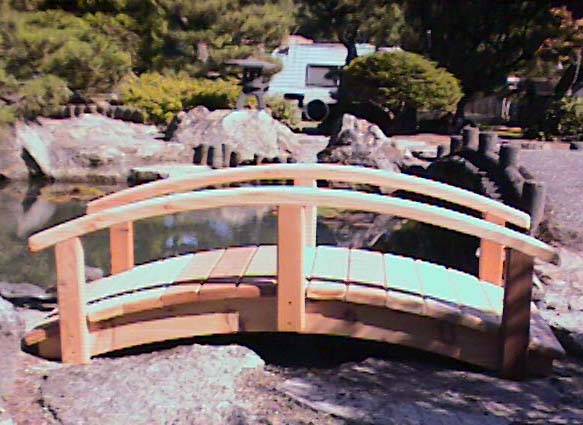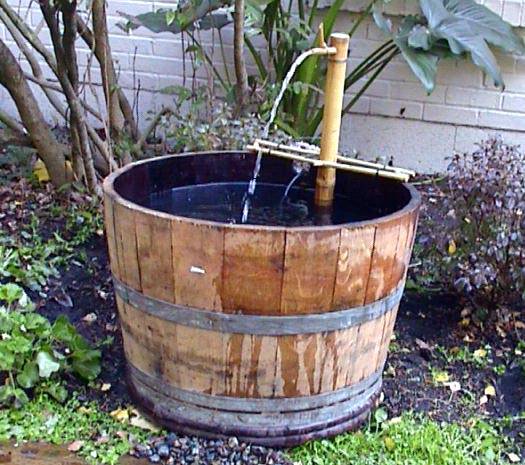Planning and Installing a Water Garden
Urban and rural dwellers can bring the interest of water into
their own backyards with a water garden (a miniature ecosystem created by
growing and nurturing aquatic plants in a body of water). There are full range
of water garden products from a water
garden
tub containers or small fountain to a large pond with waterfalls and fish,
each water garden is unique. Water gardens are easy to install and maintain.
Gardeners can introduce new plants, such as water lilies and lotus, into an
existing landscape. Children spend hours enthralled by darting water denizens,
and adults can spend many afternoons reading by a cooling fountain.
So there are basically two ways to build your water garden,
one is using water garden containers or wine barrel, some
of these tub are available up to 3' diameter, the advantage of these ready made
teak or cedar wood containers are transportable and could be set up in no time,
or you can work a project to build a pond.
Space requirements and zoning must be considered when planning
a water garden. Ample space must be left for any borders, benches, or
surrounding landscapes. In some localities, zoning ordinances may require
homeowners to erect a fence around a deep pool.
If you plan to install a water garden yourself, gather
together a pick, shovel, heavy rope or garden hose, one or two straight boards,
a spirit level, stakes for excavation, and a framing square. Bring in a supply
of builders sand to line the excavation or underliner. Estimate one ton per 40
square feet of surface. Purchase border materials (such as stone or brick) and
water-treatment supplies. Other things you may need are a submersible pump and
electric cable, a fountain or waterfall with necessary accessories (such as a
permanent pipe), and special lights or color fixtures to illuminate the pool at
night. You may wish to wait until the pool is complete and the water pH and
temperature adjusted before purchasing your plants and fish.
One or two people can install a water garden that will last
for years. The key is careful planning before digging any soil. When choosing
the location of a water garden, the gardener should consider placing it so it
can be viewed and appreciated through a window in the house.
Other important factors to consider are exposure to sunlight,
drainage, and proximity to trees. Water lilies and lotus need full sun at least
five hours and, preferably, as much as ten hours a day. A shadier spot limits
your choice of aquatic plants. A spot providing mid- to late-afternoon shade is
preferable. Soil in the site should be well drained. Water-logged soil can
distort the shape of an artificial pool and crack or break the liner. A pool
placed in sandy or crumbly soil needs to be specially prepared to prevent
caving-in of the sides. If the pond is directly under trees, leaves that fall
into the pond can decay and harm fish and plant life, as well as clog pumps and
filters.
Accessibility to electricity and water is an important
consideration. The pool is filled with tap water from a garden hose, but
occasionally needs to have water added due to evaporation. An electrical pump
recirculates water for fountains and waterfalls and operates on a normal
household current.
When deciding on pond depth, remember that shallow ponds are
quicker to cloud with excess algae. Submerged plants, floating plants, and fish
do better in deeper pools. A good, average depth is 18 to 24 inches, possibly
deeper in colder climates.
There are three ways to create a pool for your water garden.
FLEXIBLE PLASTIC LINERS are lightweight and inexpensive and can be cut to any
shape. However, installation is more time consuming than for molded pools.
PREFABRICATED FIBERGLASS POOLS are considerably more expensive, but more
durable. Generally, pre-fab pools are better on sloping grounds or fresh fill. A
CONCRETE POOL (properly installed) lasts the longest. Since inadequate mixing or
reinforcement can cause immediate cracking, a professional installation is
recommended for concrete.
If installing a liner or pre-fab pool, the steps are similar.
First, outline the pond with a heavy rope, staking it at intervals. If
installing a pre-fab pool, place the pool on the ground and outline as above,
but make it 2 inches wider in every direction than the actual pool.
Next, dig a hole the exact shape of the pool, adding 2 inches
to the depth to accommodate a layer of sand. When digging for a liner pool,
create a shallow, "boggy" area for plants by digging a 9- to
12-inch-wide shelf along the perimeter. When digging for a pre-fab pool, follow
the contours of the shell, including any built-in shelves. Clear the hole of
rocks, smooth the soil, and level the top edges to make sure the installed liner
will be camouflaged.
Line the excavation with about 2 inches of damp sand to
prevent punctures, and smooth it down. (Some suppliers carry liner underlay that
can be used instead of sand. Some liners can be used with carpeting.) Center the
liner over the hole, and push it outward into the corners. Fold the liner into
pleats where it bunches at curves and corners, and anchor it around the edge
with stones or bricks. As the pool fills with water, smooth out folds and
wrinkles. Shut off the water when it covers the liner evenly to the top on all
sides. Trim away the surplus liner, leaving about 6 inches around the edge.
Cover this flap with stones, bricks, tiles, or other paving materials.
Pre-fab shells may have to be lowered into the hole and then
removed several times to get the edges of the hole even. Once the shell is in
place, fill the pond slowly. Backfill around the shell with soil as the water
level rises to ensure the walls are adequately supported by soil. Hide the edges
of the shell with flagstones or tiles that overlap the edge by 1 or 2 inches.
Before stocking a water garden, the water should be prepared.
If the water contains ordinary chlorine, wait 24 to 48 hours to allow the
chlorine to evaporate. If chloramine or chlorine dioxide are present, ask a
water garden or fish supply house for counteractive chemicals
Planting a Water Garden
After you have planned and installed a water garden (See May
1995 Hort. Article, Planning and Installing a Water Garden), you need to
determine the plant materials to be used in the water garden. The key to a
successful, thriving water garden is balance. Plants balance a pool ecologically
by oxygenating and shading it (algae flourish in too much sunlight). Basically,
there are four types of plants suited to water gardens: deep water plants, bog
plants or marginals, oxygenators, and floating plants. A mix of all four,
properly planted, ensures a thriving, self-sustaining system.
Containers, such as lined baskets, plastic tubs, dishpans, or
clay pots, should be used to contain water plants. This will help prevent
spreading and overcrowding. Fill containers with damp, heavy garden soil (avoid
bagged potting soil or garden soil that contains chemicals or fertilizers
harmful to aquatic life), pack the soil tightly in the container, cover with pea
gravel to keep the soil from floating up, and lower the container to the correct
depth in the pond.
Plants should be introduced to the pond during the growing
season. Fish can be introduced two to three weeks after stocking with plants,
but it is best to wait four or five weeks to allow time for the plants to get
established.
Water lilies are one of the most popular pond aquatics because
they are colorful, easy to care for, and highly fragrant. Tropical water lilies
come in day-blooming and night-blooming varieties. They have larger,
more-fragrant blossoms than hardy lilies, come in more colors, and bloom more
often -- usually every day for the entire blooming season. In northern areas,
they bloom later in the season. They can be placed in the water garden when the
temperature reaches 65F at night and 75F during the day and grow best in 10 to
12 inches of water. Unless stored, they die when frost occurs. Most gardeners
store them in a greenhouse pond over winter or treat them as annuals and replace
them every year.
Hardy water lilies have longer blooming seasons in northern
regions, but they have intermittent periods of dormancy, blooming for several
weeks and then resting for several weeks throughout the blooming season. In
general, they can be planted deeper than tropical water lilies, with some
varieties surviving in 8 to 10 feet of water. They thrive in cold regions and
don't need to be removed during the winter as long as the water doesn't freeze
all the way to the rootstock. Both varieties need at least 5 and usually up to
10 to 12 hours of sun and regular fertilization.
The lotus, a relative of the water lily, is a much larger
plant with magnificent blossoms. Hardy varieties thrive anywhere in the U.S.,
but some hybrid strains are not as tough in northern climates. They have a much
shorter bloom season than lilies, but are popular because of their spectacular
leaves and seed pods that often are used in flower arrangements. They too
require at least five hours of sunlight and a water depth of 2 to 3 feet.
Because lotus require very large containers, they are better suited to larger
water gardens.
Bog plants include cattail; Japanese and water iris; bamboo;
papyrus; and other tall, grasslike plants that thrive in the boggy, shallow
areas that border the pond. Bog plants grow naturally in mud or in up to 6
inches of water, so they need to sit in a container on a "shelf" just
below the water line. Most varieties of iris require at least three hours of
sunlight and grow best in full sun. Cattails grow in partial shade or full sun.
Certain plants do not appear above the water, but are
ecologically essential for pond balance because they continually replenish the
oxygen supply in the water. Called "water weeds," they slow the growth
of algae, absorb excess nutrients that would cloud the water, and provide fish
with food. (If you have a small pool with no room for these plants, an aquarium
pump will do the job). Varieties such as "elodea/anacharis" and
"cabomba" are very inexpensive and can be bought by the bunch from
suppliers. The plants require sandy, gravel-like soil and are hardy enough to
survive the winter.
Plants, such as water hyacinth, have beautiful flowers and
keep the water clear of algae and blanket weeds by minimizing the amount of
sunlight on the surface. They do not need any soil -- just float them in the
water. However, they are not recommended for areas where they might over winter
as they are extremely invasive and have caused tremendous environmental and
economic damage in the southern United States.
Decorating a Water Garden
After the construction and planting the water garden, most of
the basic work is done, but to make it an enjoying and insparing garden, you
need to do some waterscaping to give it a final touch,


garden bridge
bamboo Garden
Garden Bridge is the most
common feature structure in the water garden, because it allow you to connect
your landscape divided by the stream or pond, a working
bamboo water garden is another eye catching center piece along your water way in the
garden, it can bring soothing water sound rhyme to your water garden.
![]() Gardeners' Corner
Kids'
Garden
Sustainable Garden
Contact Us
Gardeners' Corner
Kids'
Garden
Sustainable Garden
Contact Us![]()



